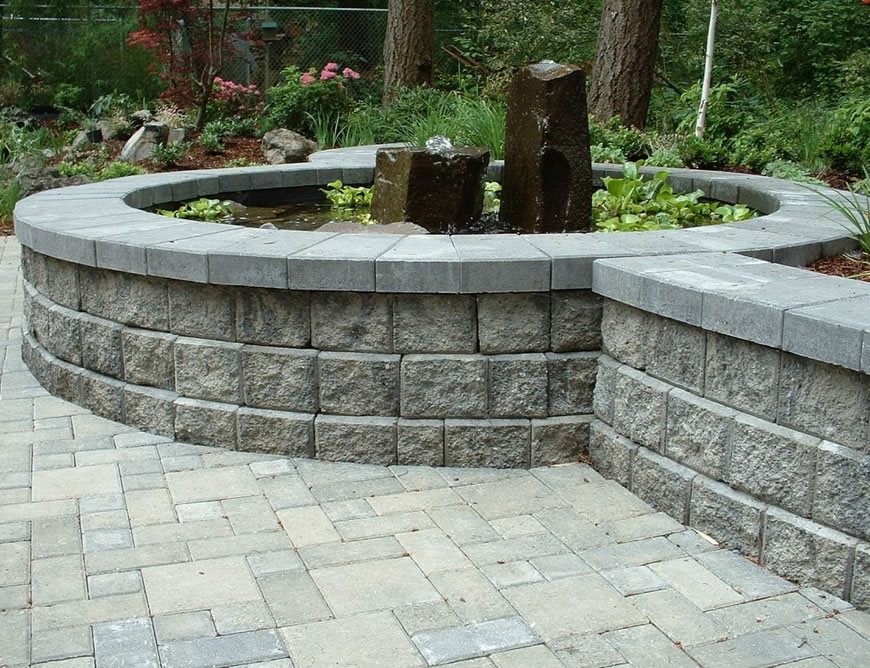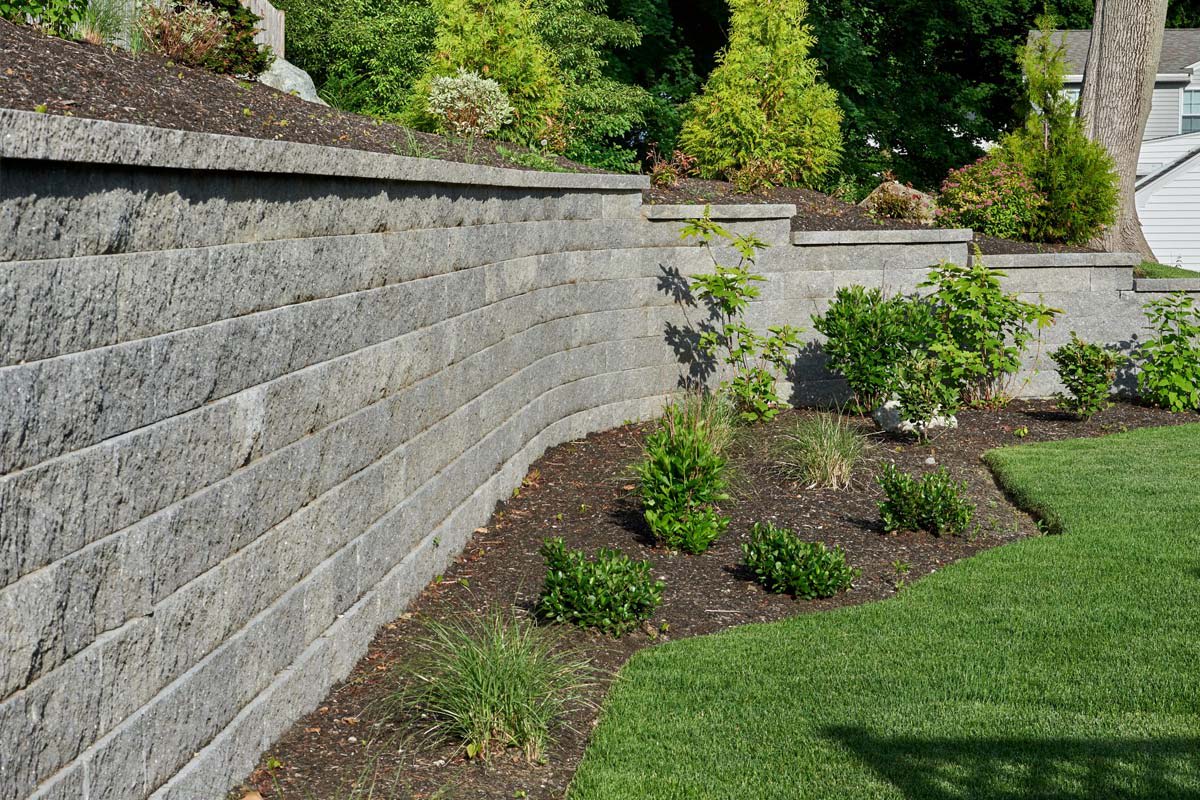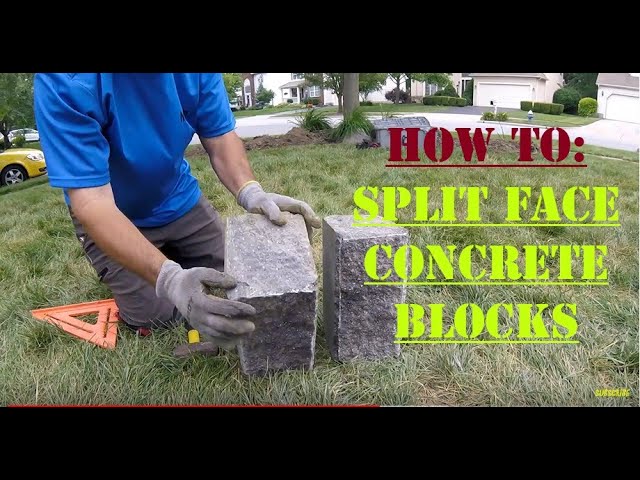To split landscaping blocks, use a chisel and hammer for precise cuts. Alternatively, a masonry saw provides clean, efficient results.
Landscaping blocks are essential for creating beautiful outdoor spaces. They can form walls, paths, and decorative features, enhancing your garden’s aesthetics. Sometimes, you may need to split these blocks for better fitting or design purposes. Mastering the art of splitting landscaping blocks can save you time and money.
Choosing the right tools and techniques ensures clean cuts and prevents damage. With the right approach, you can achieve professional results in your landscaping projects. This guide will walk you through effective methods to split blocks safely and efficiently, making your outdoor renovations a breeze. Enjoy transforming your landscape with perfectly cut blocks!

Credit: www.youtube.com
How to Split Landscaping Blocks : Step by Step Guide
Introduction To Landscaping Blocks
Landscaping blocks are essential for creating beautiful outdoor spaces. They provide structure and design to gardens. Understanding their types and roles can enhance your garden’s appeal.
The Role In Garden Design
Landscaping blocks serve various purposes in garden design. Here are some key roles:
- Define spaces: They create clear boundaries in your garden.
- Elevation: Blocks can add height to flower beds.
- Walkways: They provide stable paths for walking.
- Retaining walls: Help control soil erosion.
Types Of Blocks
Different types of landscaping blocks exist for various needs. Here’s a quick overview:
| Type of Block | Description | Common Uses |
|---|---|---|
| Concrete Blocks | Durable and versatile. | Walls, pathways, and structures. |
| Natural Stone | Beautiful and unique. | Garden borders and decorative features. |
| Retaining Wall Blocks | Specifically designed for soil retention. | Prevent soil erosion and create terraces. |
| Pavers | Flat blocks for paving. | Driveways, patios, and walkways. |
Choosing the right type enhances both function and aesthetics. Consider your garden’s needs before selecting blocks.
Tools Required For Splitting Blocks
Splitting landscaping blocks needs the right tools. Using the proper equipment makes the job easier and safer. Below are the essential tools you’ll need.
Safety Equipment
- Safety goggles: Protect your eyes from flying debris.
- Gloves: Wear heavy-duty gloves to shield your hands.
- Steel-toed boots: Prevent foot injuries from falling blocks.
- Dust mask: Keep dust out of your lungs while working.
Splitting Tools
| Tool | Description |
|---|---|
| Chisel | A sharp metal tool used to create cracks. |
| Mallet | A heavy hammer to strike the chisel. |
| Sledgehammer | A large hammer for breaking tough blocks. |
| Block splitter | A specialized tool for splitting blocks efficiently. |
Ensure all tools are in good condition. Inspect them for damage before use. Using high-quality tools saves time and effort.
Preparing The Blocks For Splitting
Before you start splitting landscaping blocks, preparation is key. Properly preparing the blocks ensures clean splits and reduces damage. Follow these steps to get the blocks ready.
Cleaning The Surface
Cleaning the surface of the blocks is essential. Dust and debris can affect the splitting process. Here’s how to do it:
- Use a stiff brush to remove dirt.
- Wash the blocks with water.
- Allow them to dry completely.
Ensure no loose particles remain on the surface. A clean block will split more easily.
Marking The Split Line
Marking the split line helps guide your tool. This step is crucial for accuracy. Follow these steps:
- Use a chalk line or marker.
- Draw a straight line where you want to split.
- Make sure the line is visible and clear.
Double-check the alignment before proceeding. A well-marked line ensures a precise cut.

Credit: www.landscapingnetwork.com
Techniques For Manual Splitting
Splitting landscaping blocks can be done manually. This method is cost-effective and allows for precise control. Two popular techniques include using a chisel and hammer and applying the split. Each technique has its unique steps and tools.
Using A Chisel And Hammer
This method requires minimal tools. You will need a chisel, a hammer, and safety goggles. Follow these steps:
- Select the right chisel: Use a masonry chisel.
- Mark the block: Draw a line where you want to split.
- Position the chisel: Place it on the marked line.
- Strike the chisel: Use the hammer to hit the chisel firmly.
- Repeat as needed: Continue striking until the block splits.
Always wear safety goggles. This protects your eyes from flying debris.
Applying The Split
Applying the split technique requires careful preparation. Follow these steps for successful splitting:
- Choose a stable surface: Use a solid workbench or ground.
- Secure the block: Use clamps to hold it in place.
- Determine the split line: Mark where to split accurately.
- Use a sledgehammer: Hit the center of the block forcefully.
This technique is great for larger blocks. Ensure you wear protective gear during the process.
Using Power Tools For Precision
Using power tools offers precision and efficiency for splitting landscaping blocks. Proper tools can make the job easier and ensure clean cuts. This section covers how to choose the right saw and guidelines for safe use.
Choosing The Right Saw
Selecting the correct saw is vital for effective cutting. Here are the popular saw options:
| Type of Saw | Best For | Key Features |
|---|---|---|
| Wet Saw | Large blocks | Water cooling, smooth cuts |
| Angle Grinder | Small to medium blocks | Portable, fast cutting |
| Chop Saw | Various sizes | Powerful, precise angles |
Choose the saw that fits your project needs. Ensure it has the right blade for cutting landscaping blocks.
Guidelines For Safe Use
Safety is crucial when using power tools. Follow these guidelines:
- Wear safety goggles to protect your eyes.
- Use ear protection to guard against noise.
- Wear gloves to prevent cuts and scrapes.
- Ensure the work area is clear of debris.
- Check the tool before use for any damage.
Follow these steps for safe operation:
- Secure the block to prevent movement.
- Align the saw blade with your cut line.
- Turn on the tool and wait for it to reach full speed.
- Make the cut steadily, without forcing the tool.
- Turn off the tool and wait for the blade to stop.
Adhering to safety guidelines protects you and ensures successful cutting.

Credit: homeguide.com
Finishing Touches After Splitting
After splitting landscaping blocks, finishing touches enhance their appearance and usability. Proper care makes them look great and ready for your project.
Smoothing Rough Edges
Rough edges can be sharp and unattractive. Smoothing them improves safety and aesthetics. Here are steps to follow:
- Use a masonry file or angle grinder.
- Wear safety goggles and gloves.
- Work slowly to avoid removing too much material.
- Focus on corners and edges for a clean finish.
After smoothing, check for any remaining sharp spots. A smooth block is easier to handle and looks more polished.
Cleaning The Blocks
Cleaning your blocks removes dust and debris. This step is vital for a professional look. Follow these steps for effective cleaning:
- Use a stiff brush to remove loose dirt.
- Mix water with mild detergent.
- Scrub the blocks with the soapy water.
- Rinse thoroughly with clean water.
- Allow them to dry completely before installation.
Keeping blocks clean helps them bond well with mortar or adhesive. Clean blocks also enhance the overall look of your landscape.
Creative Uses For Split Blocks
Split landscaping blocks offer many creative options for your garden. They enhance beauty and structure. Here are some popular uses that can transform your outdoor space.
Building Planters
Split blocks make excellent planters. They provide a sturdy, unique look. Follow these steps to create your own:
- Select your location.
- Choose the size of your planter.
- Arrange the blocks in a desired shape.
- Fill the bottom with drainage material.
- Add soil and plant your favorite flowers or herbs.
Consider these benefits:
- Durability against weather.
- Low maintenance requirements.
- Customizable designs.
Creating Borders
Split blocks work well for garden borders. They create clear boundaries between areas. This helps organize your landscape. Here are some ideas:
| Purpose | Design Idea |
|---|---|
| Flower Beds | Outline with blocks for a defined look. |
| Pathways | Use blocks to guide foot traffic. |
| Vegetable Gardens | Separate different plant types. |
Benefits of using split blocks for borders include:
- Enhanced aesthetic appeal.
- Clear definition of spaces.
- Prevents soil erosion.
Maintenance And Care
Maintaining your landscaping blocks keeps them looking fresh and lasting longer. Regular care ensures they stay in good shape. Simple checks can prevent bigger issues down the road.
Routine Checks
Perform routine checks every few months. Look for any signs of wear or damage. Here are some key points to monitor:
- Check for cracks or chips.
- Inspect the color and texture.
- Look for any uneven settling.
- Ensure proper drainage around the blocks.
Keep a maintenance log. Note any changes you observe during checks. This helps track the condition of your blocks.
Repairing Damaged Blocks
Repairing damaged blocks is vital for overall aesthetics. Follow these steps for effective repairs:
- Identify the damaged area.
- Clean the surface thoroughly.
- Use a suitable filler for cracks.
- Allow the filler to dry completely.
- Seal the block to protect it from future damage.
For larger damages, consider replacing the block. Measure accurately to find a matching replacement. This ensures a seamless look.
| Damage Type | Repair Method |
|---|---|
| Small cracks | Use filler and sealant |
| Chips | Replace with a new block |
| Uneven blocks | Re-level and secure |
Regular maintenance enhances the beauty of your landscape. Invest time in care to enjoy the long-term benefits.
Frequently Asked Questions
How Do You Split Landscaping Blocks Effectively?
To split landscaping blocks effectively, use a chisel and a hammer or a block splitter. Mark the line where you want to split the block. Position the chisel on the marked line and strike it firmly. Continue this process until the block separates cleanly.
What Tools Are Needed To Split Landscaping Blocks?
Essential tools for splitting landscaping blocks include a hammer, chisel, and safety goggles. You may also use a block splitter or masonry saw for larger jobs. Ensure you have protective gear to avoid injuries. Proper tools make the splitting process smoother and more efficient.
Can Landscaping Blocks Be Cut Without Special Tools?
Yes, landscaping blocks can be cut without special tools. Using a hammer and chisel can be effective for smaller jobs. For larger blocks, consider renting a masonry saw. Always ensure you mark your cutting line clearly for better accuracy and results.
Is It Safe To Split Landscaping Blocks At Home?
Yes, splitting landscaping blocks at home is generally safe. However, wearing safety goggles and gloves is crucial to protect against flying debris. Always work in a well-ventilated area. Following proper techniques and using the right tools can minimize risks significantly.
Conclusion
Splitting landscaping blocks can enhance your outdoor projects. With the right tools and techniques, the process becomes easier and safer. Always prioritize safety and follow best practices. By mastering these skills, you can create beautiful landscapes that last. Happy landscaping, and may your outdoor spaces flourish with creativity!

